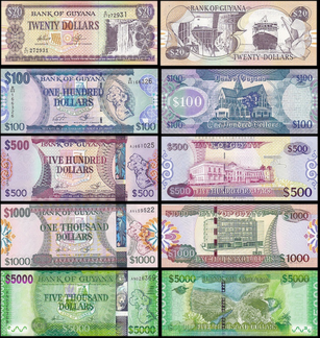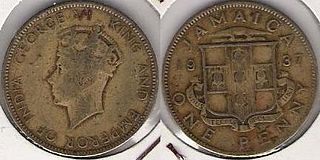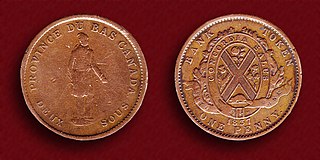The history of currency in the British colony of Saint Vincent closely follows that of the British Eastern Caribbean territories in general. As such, it should not be considered in isolation. In order to get a broad overview of currency in the region, see the article British West Indies dollar.

Saint Vincent and the Grenadines is an Anglo-Caribbean country in the Lesser Antilles island arc, in the southern portion of the Windward Islands, which lies in the West Indies at the southern end of the eastern border of the Caribbean Sea where the latter meets the Atlantic Ocean. The sovereign state is also frequently known simply as Saint Vincent.
The British West Indies dollar (BWI$) was the currency of British Guiana and the Eastern Caribbean territories of the British West Indies from 1949 to 1965, when it was largely replaced by the East Caribbean dollar, and was one of the currencies used in Jamaica from 1954 to 1964. The monetary policy of the currency was overseen by the British Caribbean Currency Board (BCCB). The British West Indies dollar was never used in British Honduras, the Cayman Islands, the Turks and Caicos Islands, the Bahamas, or Bermuda.
Contents
Even though Queen Anne's proclamation of 1704 brought the gold standard to the West Indies, silver pieces of eight (Spanish dollars and later Mexican dollars) continued to form a major portion of the circulating currency right into the latter half of the nineteenth century. Britain adopted the gold standard in 1821 and an imperial order-in-council of 1838 resulted in British sterling coinage being introduced to St. Vincent in the year 1839. However, despite the circulation of British coins in St. Vincent, the silver pieces of eight continued to circulate alongside them and the private sector continued to use dollar accounts for reckoning. The international silver crisis of 1873 signalled the end of the silver dollar era in the West Indies and silver dollars were demonetized in St. Vincent in 1879 for fear that the silver standard might return. Even though the British sterling coins were made of silver, they were fractional coins of the British gold sovereign and hence they maintained their gold value. This left a state of affairs, in which the British coinage circulated, being reckoned in dollar accounts at an automatic conversion rate of 1 dollar = 4 shillings 2 pence.

The pound sterling, commonly known as the pound and less commonly referred to as sterling, is the official currency of the United Kingdom, Jersey, Guernsey, the Isle of Man, South Georgia and the South Sandwich Islands, the British Antarctic Territory, and Tristan da Cunha. It is subdivided into 100 pence. A number of nations that do not use sterling also have currencies called the pound.

The shilling is a unit of currency formerly used in Austria, the United Kingdom, Australia, New Zealand, United States and other British Commonwealth countries. Currently the shilling is used as a currency in four east African countries: Kenya, Tanzania, Uganda and Somalia. It is also the proposed currency that the east African community plans to introduce . The word shilling comes from old English "Scilling", a monetary term meaning twentieth of a pound, and from the Proto-Germanic root skiljaną meaning 'to separate, split, divide.' The word "Scilling" is mentioned in the earliest recorded Germanic law codes, those of Æthelberht of Kent.
From 1949, with the introduction of the British West Indies dollar, the currency of St. Vincent became officially tied up with that of the British Eastern Caribbean territories in general. The British sterling coinage was eventually replaced by a new decimal coinage in 1955, with the new cent being equal to one half of the old penny.








